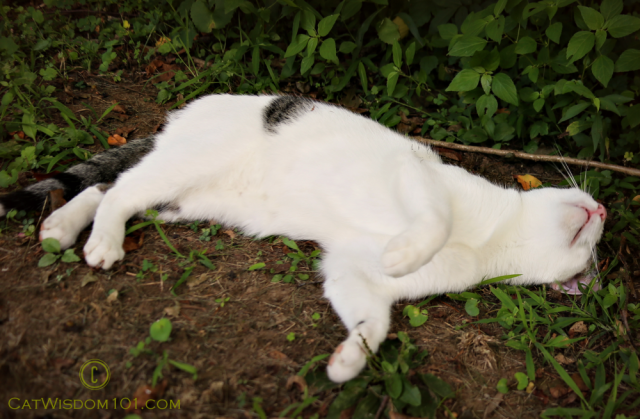Vet 101: Diagnosis & Tests : Getting The Whole Picture
If you’ve ever wondered how and why vets order ancillary tests, read on. Veterinarian, Dr. Rich Goldstein from Mobile Vet Squad shares his perspective on getting the whole picture with a diagnosis and tests.

As the practice of veterinary medicine advances, many tests are now available to help in the diagnosis of feline diseases. But are these tests always necessary? One of my favorite professors in vet school once said, “Nothing replaces your hands when diagnosing a cat’s problem.” A thorough physical exam is essential (and pretty easy to do!) in properly evaluating a sick kitty. Over the years, that phrase has stayed in the back of my mind with every patient I see. Nothing drives me more insane than seeing a new doctor walk into a room, not even touch the cat, and order a bunch of tests.
Cats are masters at hiding their symptoms. But if you pay close attention, most of the time, they’ll let you know what’s wrong — or at least put you on the right track to figuring it out. Then, after a thorough exam, the vet and the caretaker can decide which tests are necessary to guide you along the right path to the answer.
Don’t get me wrong. There are times when testing is absolutely required to hone in on the problem so that proper treatment options can be discussed. I say treatment options, because each cat is an individual. Like shoes, one size does not fit all cats and all owners. There are always options. But you have to find the problem first. So let’s take a look at some of the “ancillary” tests that may be needed to accompany a good physical exam, and the information they can provide.
The most important ancillary test is baseline bloodwork, which should include a complete blood count (CBC), chemistry profile (CHEM), urinalysis (UA), and sometimes a thyroid level (T4). (It’s also important to know and sometimes recheck a sick cat’s Feline Leukemia (Felv) and Feline Immunodeficiency Virus (FIV) status). While cats may outwardly mask their illnesses, blood tests will often reveal them. (This is one reason why we often recommend checking a cat’s bloodwork as part of a routine annual or semi-annual exam).
The CBC assesses the numbers of red blood cells (RBC’s), and white blood cells (WBC’s). It can give us an idea of how the bone marrow is working in response to different disease conditions. For example, a decrease in the RBC’s indicates anemia. An increase in the number of WBC’s can indicate infection or stress or some forms of leukemia. A change in the types of WBC’s can also point us towards certain diseases. A CHEM profile tells us how the various organs in the body are working. For example, an increase in the serum alkaline phosphatase (SAP or ALP) means something is upsetting the liver. An increase in the T4 can indicate hyperthyroidism. An increase in the blood sugar can indicate diabetes. An elevated BUN and creatinine can indicate kidney disease. The UA is an easy test that gives so much information into the health of the urinary tract, and is essential in the diagnosis of diabetes mellitus.
Xrays, or radiographs, allow us to essentially take a picture of the inside of the cat. But what exactly do xrays look for? When evaluating xrays, we’re looking to see if everything appears to be in the right position, is the right size and shape, and is anything there that shouldn’t be there. Depending on the body area being examined, xrays can help determine everything from broken bones, to tumors in the belly, to foreign objects in the stomach, to pneumonia or fluid in the lungs. It is a very useful tool in getting an overall picture of how things look internally. While xrays do provide an invaluable piece of the puzzle, they’re not perfect. Suppose there is a problem on the inside of a particular organ? To evaluate that issue, ultrasound may need to be employed.
Ultrasound is a great non-invasive way to see the insides of individual organs by using harmless sound waves. It can be used to diagnose heart disease, look for tumors, even detect pregnancy. Many vets now either have ultrasound machines on the premises, or can have a specialist come to the practice to perform the procedure. Xrays and ultrasound provide different pieces of information, and are often interpreted together.
In some cases, very advanced diagnostic tests may be warranted, including CT scans, MRI’s, and endoscopy. CT and MRI offer incredibly detailed images of the brain, spinal cord, and other tissues, that allow visualization of brain tumors, slipped discs, and other abnormalities. Endoscopy allows us to see the inside of the GI tract and urinary bladder without surgical intervention. These tests often require referral to an advanced care facility.
As you can see, the list of tests can get quite large and seem endless. This endless list, however, brings me back to a very important point: “Nothing replaces your hands when diagnosing a cat’s problem.” Tests should be run to rule a problem in or out, not to go on a wild goose chase. We’ve talked before about the importance of having an open line of communication with your vet. Before embarking on a potentially very expensive journey (not to mention a potentially stressful journey for the kitty!), ask the vet what he’s looking for. What is the cat saying through her physical exam, and what are you noticing as part of the history at home? The puzzle may have 1000 pieces, but there is always a complete picture at the end.




10 Comments
Texas, a cat in New York
That was very interesting, thank you. My human is keeping it for potential future reference.
Purrs
Oui Oui
I changed vets a couple years ago and am very happy with my new one. He is very sharp and intuitive.
meowmeowmans
Such a great post, and terrific advice! We just had our blood work, too … everything checked out, thank Cod!
Abby
No matter if it’s a furry or non furry subject, medical testing is sometimes a shot in the dark. But this was an excellent posting and very informative.
purrs
>^,,^<
✿•*¨`*•. ♥Abby♥Boo♥Ping♥Jinx♥Grace♥✿•*¨`*•.
CATachresis
When I read your Vet 101 posts I always think “Hmm! I should really change my vet!”
Connie Marie
Very informative article! I liked the explanations for the different tests.
I’been to both types and greatly prefer the one who’ll ask me questions and examine my cat. Always does a fecal sample, which I don’t mind at all because he looks for things besides worms. I’ve been lucky that only one blood test had to be done. I’m lucky to have him. I enjoy your Vet 101.
Have a Wonderful day Layla,
Connie
Brian
Thanks for such wonderful info! I just had my blood work done at our new vet and all came back okay.
da tabbies o trout towne
grate post two day and veree troo…knot all cats can fit de “same shoo” even siblings….hope yur day iz a grate one !!
JJ
Valuable info. Hands on is best.
Katie Isabella
I really appreciate this article. My now deceased cat was examined thoroughly while ill and had quite a battery of tests that even I as a well read lay person knew were necessary to diagnose and to determine treatment for my little one then.